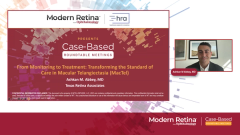
Navigating the Gray Zone in MacTel Type 2: When to Treat Early or Advanced Disease
A panelist discusses how individualized imaging-based decisions guide when to initiate NT-501 therapy in both early and advanced stages of MacTel type 2.
A panelist discusses how selecting the first eye for NT-501 implantation and counseling patients requires balancing clinical logic with patient expectations. A representative case of a middle-aged woman demonstrated that traditional acuity tests, such as Snellen, often underestimate real functional deficits in MacTel. The discussion emphasized incorporating microperimetry and low-luminance visual testing to assess the quality of vision more accurately. When determining which eye to treat first, the better-seeing eye was favored to maximize long-term vision preservation, despite potential patient hesitancy. The panel also reviewed procedural considerations, including a small subset of patients experiencing mild miosis or delayed dark adaptation, which should be addressed preoperatively to ensure satisfaction. By focusing on transparent communication, accurate functional assessment, and a patient-centered approach, clinicians can improve acceptance and outcomes for NT-501 therapy in bilateral disease.
Newsletter
Keep your retina practice on the forefront—subscribe for expert analysis and emerging trends in retinal disease management.













































